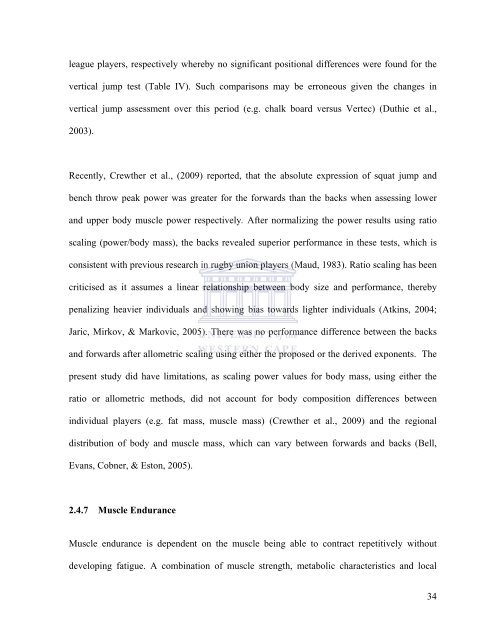Physical fitness of elite women's rugby union players over a ...
Physical fitness of elite women's rugby union players over a ...
Physical fitness of elite women's rugby union players over a ...
Create successful ePaper yourself
Turn your PDF publications into a flip-book with our unique Google optimized e-Paper software.
league <strong>players</strong>, respectively whereby no significant positional differences were found for the<br />
vertical jump test (Table IV). Such comparisons may be erroneous given the changes in<br />
vertical jump assessment <strong>over</strong> this period (e.g. chalk board versus Vertec) (Duthie et al.,<br />
2003).<br />
Recently, Crewther et al., (2009) reported, that the absolute expression <strong>of</strong> squat jump and<br />
bench throw peak power was greater for the forwards than the backs when assessing lower<br />
and upper body muscle power respectively. After normalizing the power results using ratio<br />
scaling (power/body mass), the backs revealed superior performance in these tests, which is<br />
consistent with previous research in <strong>rugby</strong> <strong>union</strong> <strong>players</strong> (Maud, 1983). Ratio scaling has been<br />
criticised as it assumes a linear relationship between body size and performance, thereby<br />
penalizing heavier individuals and showing bias towards lighter individuals (Atkins, 2004;<br />
Jaric, Mirkov, & Markovic, 2005). There was no performance difference between the backs<br />
and forwards after allometric scaling using either the proposed or the derived exponents. The<br />
present study did have limitations, as scaling power values for body mass, using either the<br />
ratio or allometric methods, did not account for body composition differences between<br />
individual <strong>players</strong> (e.g. fat mass, muscle mass) (Crewther et al., 2009) and the regional<br />
distribution <strong>of</strong> body and muscle mass, which can vary between forwards and backs (Bell,<br />
Evans, Cobner, & Eston, 2005).<br />
2.4.7 Muscle Endurance<br />
Muscle endurance is dependent on the muscle being able to contract repetitively without<br />
developing fatigue. A combination <strong>of</strong> muscle strength, metabolic characteristics and local<br />
34
















